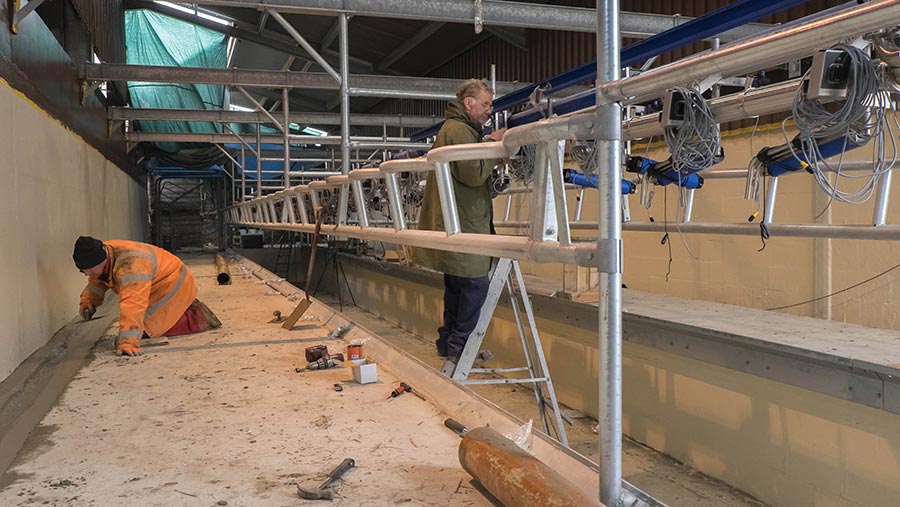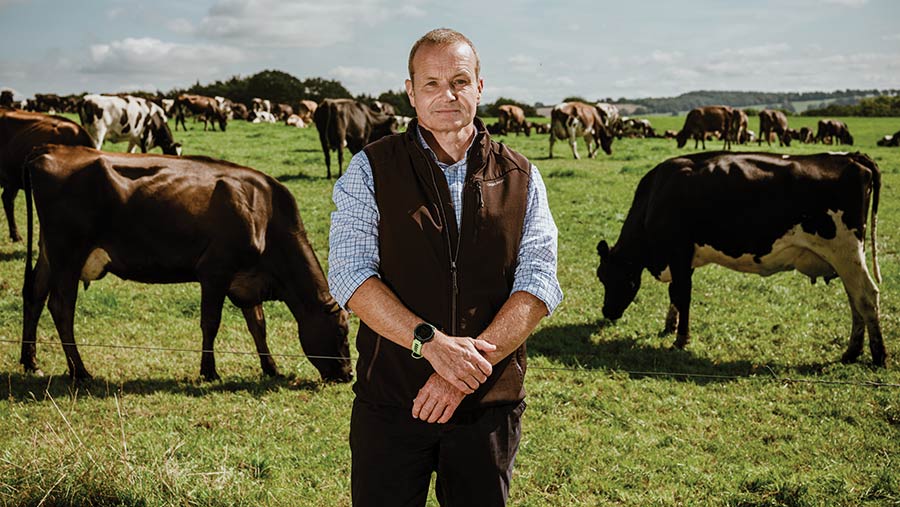Advice on milking machine maintenance for spring block-calvers
 © Tim Scrivener
© Tim Scrivener Spring-calving herds with a tight block and a full parlour shutdown can plan to do their milking machine maintenance, servicing and any upgrades during the dry period.
But parlour servicing intervals and liner replacements are based on hours, not dates, so it is important to consider the effect on the schedule of dropping a milking, or increasing cow numbers, to maximise parlour efficiency.
See also: Benefits of training heifers to use the parlour
Parlour specialist Ian Ohnstad, of The Dairy Group, says changing liners is a bit like maintaining a car: instead of the job being done by date, recommended service intervals happen according to mileage.
“Silicone liners last 5,000 milkings, but typical black rubber liners need replacing after 2,500 milkings. Backflushing takes 10% off liner life – this means 250 fewer milkings,” he says.
Timing of liner replacement
“If you have 300 cows, milked twice a day through a 20/40 herringbone, each unit milks 30 cows a day. Divide 2,500 milkings by 30 and this means liners should be changed every 83 days – almost every three months.”
More cows (from larger herds) through the parlour reduces liner life, as does continuing to milk minimal numbers of cows (even if the bulk of the herd is dry) until calving.
Fewer milkings, on the other hand (such as switching to once-a-day in late lactation), will extend the time until changeover.
However, replacing liners is not a job to do immediately after the last milking of the season.
Ian points out that rubber liners start to deteriorate once they are exposed to the atmosphere – even when they are not being used.
He advises keeping them in sealed, dry bags in a dark environment, and only putting them on clusters just before the first milking of the season. “Don’t change liners the day you stop milking, do it one to two days before you start up again, to maximise their efficient life,” he says.

Ian Ohnstad ©MAG/Colin Miller
Parlour access
The advantage of having the whole herd dry by a set cut-off day in the diary is that it makes it easier to book an engineer, who can block out their time.
Plus, there is the opportunity to have parlour access and work all day, rather than have to fit in maintenance between milkings.
Being organised also helps with farm cashflow, as the job can be budgeted for even in a month without milk income.
“Book your engineer; the sooner the better. But if you are still milking and the parlour never really stops, this requires more planning for work done between milkings and it also affects your [service] intervals.
“An upgrade – whether it is technology such as milk meters or feeders, or a parlour extension – is best done when there are no cows being milked.”
Historically, Ian says parlour service intervals have been annual, with an interim check, equivalent to roughly every 750 and 1,500 hours.
“With a 150-cow herd, milking a total of six hours a day, this is six months and 12 months. Milking significantly more cows than this results in shorter service intervals.”
Service schedule guidelines
To meet Red Tractor guidelines, a parlour must have an annual static test, and a dynamic test is recommended (see “Parlour servicing intervals”).
This means each herd must work out a maintenance schedule based on these guidelines, and also assess how their milking system may affect service intervals.
“It’s also worth speaking to your parlour engineer about cow numbers and milking frequency, because some pulsators have two- to three-year service intervals,” he adds.
Once rubberwear has been upgraded and routine maintenance completed, the static test can be done before milking starts again.
Because a dynamic test is carried out at milking, it is not possible during a parlour shutdown.
For a true picture, Ian says it must be done at peak production, because once cows are up to 35 litres/day in April, the milking machine is working hard. “So plan for two bits of parlour testing,” he advises.
Routine maintenance is not restricted to the milking plant – it is a good time to tidy stalls that might have been damaged, as well as make sure that teat spray units are working efficiently.
Ian says they should create a cone-shaped mist of disinfectant, instead of a one-sided one.
This might involve changing nozzles, checking pressure and filters. Auto-drafting systems and backing gates can be greased and serviced.
“Depending on your geography – particularly in hard-water areas – it is a good time to drain and descale your water heater ready for the season. And don’t forget to get your weigh scales out and calibrate in-parlour feeders.”
Final wash
The last job before parlour shutdown – and the first one before milking starts up again – is to give the plant a full, regular hot wash.
“After the last milking, make sure everything drains completely, especially if you use hypochlorite, as anywhere that collects water risks freezing in cold weather, and hypochlorite can start to deteriorate rubber on contact.”
Parlour servicing intervals
- Red Tractor guidelines state a parlour must have an annual static test and it is recommended to have a “milking time” assessment. This is a dynamic test plus an inspection of operator routines and teat cleanliness
- An audit will ask to see receipts for new liners
- Liners should be replaced according to the manufacturer’s instructions
- A competent engineer or technician accredited with the Milking Equipment Association, or similar, must be employed
Source: Ian Ohnstad
